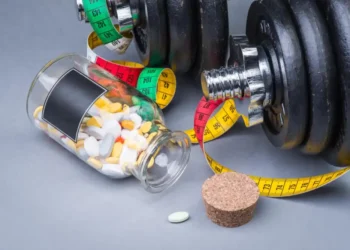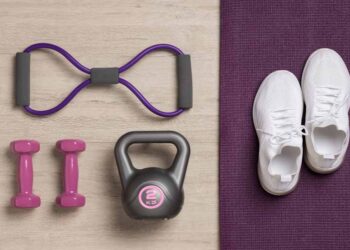Active recovery workouts help you recover faster after intense exercises. They improve your muscle recovery too. This type of exercise is low intensity.
It boosts blood flow and decreases muscle stiffness. It also lessens soreness after tough workouts. Active recovery is key to staying fit and active while giving your body a break.
Key Takeaways:
- Active recovery workouts promote faster post-workout recovery and muscle recovery.
- They improve blood flow, reduce muscle stiffness, and alleviate post-workout soreness.
- Gentle cycling, light jogs, walks, swimming, and low-impact exercises like yoga are great options for active recovery.
- Active recovery workouts can be integrated into your routine after a big workout or on “in-between days”.
- It’s important to listen to your body’s fatigue levels and balance active recovery with complete rest days.
What Is Active Recovery and What Are the Benefits?
Active recovery is a gentle way to exercise for faster recovery. It lets your body move without being too intense. This type of exercise is great for muscle recovery and reduces stiffness and soreness after workouts.
It’s all about gentle movement to get your blood flowing. This sends fresh oxygen and nutrients to your muscles. At the same time, it helps take away waste built up from working out. This is key for a quicker recovery.
Science shows that active recovery boosts muscle recovery more than just resting does. These light exercises get your blood moving. This is a key part of helping your body heal faster.
“Active recovery is a valuable tool for anyone serious about their fitness journey. Incorporating low-intensity exercise into your routine not only helps your body recover faster but also prepares you for future workouts.” – Dr. Mark Johnson, Sports Medicine Specialist
This method works for any kind of exercise enthusiast. If you’re into endurance sports, weightlifting, or just hitting the gym, active recovery is great. It not only helps you recover but also keeps injuries at bay and makes your training more regular.
Now, it’s clear why active recovery is so beneficial. Next, let’s see when and how to add these exercises to your routine for the best results.
When Should You Do Active Recovery Workouts?
Timing is key for active recovery workouts in your fitness plan. Place these sessions well to boost your recovery from races. This also helps make your off-days more productive while still being gentle.
Try to do these workouts right after a hard session, like a race. Studies prove they make you do better in follow-up workouts. These routines push out harmful substances in your muscles. This speeds up healing and lessens the ache.
They’re also great on days between intense workouts. Use these moments to rest up without being completely inactive. Light activities like walking or easy swimming keep your muscles moving. This helps without tiring you out more.
Remember, finding the right mix between activity and rest is crucial. Active recovery is good, but you also need full breaks to fully recharge. Everyone’s tiredness is different, so pay attention to when your body asks for a break from these light exercises.
Below is a guide showing the best moments for these workouts:
| Timing | Details |
|---|---|
| After a big workout (e.g., race or intense event) | Doing light exercises straight after tough sessions boosts your recovery and future performance. |
| “In between days” with mild muscle soreness | If you’re a bit sore but still able, choose active recovery. It’s light movement that helps without overworking. |
Always tailor your recovery plan to your body’s signals. And if you’re unsure, talk to an expert for clear advice.
Different Types of Active Recovery
Active recovery means doing light activities to help your body heal. If you love Peloton or are a runner, you have many choices.
If Peloton is your thing, do a slow bike ride and then some stretching or yoga. Peloton is great for that.
Runners might take a light jog or go for a walk to rest their muscles. Or they could try cycling, swimming, or yoga to mix things up.
Strength trainers can choose gentle cardio, a bit of swimming, or some yoga. These light activities keep the blood flowing without pushing too hard.
Enjoy rowing? Low-impact exercises like biking, swimming, and stretching are perfect for muscle recovery. They help avoid stiffness too.
Duration of Active Recovery Workouts
How long you spend on active recovery depends on what works for you. A brief, light exercise helps, but 20 to 30 minutes can do more for muscle repair.
Consider yoga or swimming for longer recovery sessions. They mix gentle movement with calm, aiding your muscles better.
Muscle-Specific Recovery
Active recovery can focus on certain muscle areas. With low workouts, stretch or move in ways that help the muscles you used a lot.
| Muscle Group | Recommended Active Recovery Exercise |
|---|---|
| Lower body (quads, hamstrings, calves) | Gentle cycling or walking |
| Upper body (shoulders, arms) | Yoga or light swimming |
| Full body | Yoga or swimming |
Tailor active recovery to the muscles that need care. This helps heal them and avoid future injury.
The Benefits of Active Recovery Workouts
Active recovery workouts are great for your body. They use light exercises to boost blood flow. This cuts down on muscle soreness after you work out hard. Plus, it helps your muscles bounce back faster.
- Muscle Recovery: These workouts speed up how fast your muscles get better. By lowering the lactic acid that builds up, they reduce how tired and sore you feel after tough exercises.
- Blood Flow: Doing light exercises during recovery boosts muscle blood flow. This means more oxygen and nutrients get to your muscles. It also helps take away waste that can slow down healing.
- Soreness Reduction: Such workouts ease the pain you might feel after exercising. They stretch tight muscles, making them less stiff. This makes your muscles more flexible and feels better.
Active recovery lets you keep up with your exercise schedule. It does this without tiring out your body. It’s a great addition to “off” days from hard workouts. This balance helps you recover well and perform your best.
“Active recovery workouts are a valuable tool in achieving faster muscle recovery and reducing post-workout soreness. With proper blood flow and reduced lactic acid buildup, active recovery helps your body bounce back more efficiently.”
Adding active recovery activities is key to reaping the benefits fully. It could be a light stroll, easy bike ride, or calm yoga. Pick something fun that meets your fitness targets. Remember, mix active recovery with real rest days for top muscle recovery.
The Benefits of Active Recovery Workouts:
| Benefits | Description |
|---|---|
| Muscle Recovery | Reduces lactic acid buildup and promotes faster muscle recovery. |
| Blood Flow | Increases blood circulation to deliver oxygen and nutrients while removing waste products. |
| Soreness Reduction | Loosens tight muscles, reduces stiffness, and promotes muscle flexibility, leading to less post-workout soreness. |
Keep in mind, active recovery should work with rest days, not replace them. Mixing these light exercises into your plan boosts recovery and your running for the next workout.
Active Recovery vs. Passive Recovery
Rest and recovery days offer two main choices: active recovery and passive recovery. Each way helps your body heal from tough workouts.
Active recovery means doing light exercise like gentle cycling or yoga on rest days. It keeps you moving and helps your body heal faster by boosting blood flow to your muscles.
Passive recovery is about doing nothing. This method gives your body a full rest without exercise. It’s especially good for healing injuries, fighting fatigue, or taking a break.
Using both active and passive recovery is vital for the best healing and performance. Let’s explore their advantages further:
Benefits of Active Recovery
Active recovery has many pluses for your healing process:
- It increases blood flow, pumping oxygen and nutrients while removing harmful waste. This helps with muscle recovery and lowers lactic acid.
- Active recovery clears out lactic acid from your muscles, lessening soreness and fatigue.
- By staying active, your muscles stay flexible and loose, avoiding stiffness.
- It speeds up recovery, keeping you on a consistent workout schedule and preventing tired muscles.
Benefits of Passive Recovery
But, taking it easy with passive recovery has its own benefits:
- It helps prevent injuries by giving your body time to heal and fix tissues.
- Passive recovery lets your muscles fully rest, reducing tiredness and the risk of overworking.
- Also, it refreshes your mind, readying you to tackle workouts ahead with new energy and focus.
Mixing active and passive recovery wisely maximizes healing. It lets you perform better in your workouts. Always pay attention to what your body needs and adjust your recovery methods to fit your situation and fitness level.
| Active Recovery | Passive Recovery |
|---|---|
| Involves low-intensity exercise | Requires complete rest or inactivity |
| Increases blood flow | Aids in injury prevention |
| Clears lactate buildup | Reduces fatigue |
| Reduces muscle stiffness | Promotes mental rejuvenation |
Types of Active Recovery and How They Work
Active recovery offers many options based on your needs and what you hope to achieve. Let’s look at the different kinds and how they help with muscle recovery and rest day optimization.
Cooldown
After a tough workout, cooling down is key to letting your body relax. Light activities like walking or easy cycling are good for this. They help remove waste, easing soreness and stiffness. Adding a cooldown helps your body move from work to rest more smoothly, quickening your recovery.
Interval Training
During breaks in interval training, doing light exercises for active recovery works wonders. Instead of sitting still, activities like walking, stretching, or soft yoga can make a big difference. They keep your muscles limber and improve blood flow. This allows your body to bounce back quicker, leading to better performance the next round.
Rest Days
On days off after hard workouts, stay active without pushing yourself too much. Simple exercises like a brisk walk, light jog, swim, or yoga help. They get the blood moving, cut down on muscle tightness, and aid recovery. These tasks keep your training momentum without stressing your body’s healing process.
“Active recovery is a vital part of any comprehensive training program. It helps to increase blood flow, maintain flexibility, and promote efficient recovery, ensuring you’re ready for your next workout.” – Dr. Sarah Thompson, Sports Physician
To make the most of active recovery, keep the intensity low and pay attention to how you feel. It’s important not to push too hard. Mix up various recovery exercises to boost muscle healing and keep up your peak performance on training days.
Conclusion
Active recovery workouts are key to your fitness, helping with muscle recovery and well-being. They include light exercises on your rest days for better recovery. These exercises boost blood flow, lessening soreness and stiffness after workouts.
Include activities like gentle cycling, walking, swimming, or yoga in your active recovery. It’s vital to balance active recovery with total rest. Everyone needs different amounts of rest, so listen to your body. Striking the right balance keeps your body ready for hard workouts.
Active recovery isn’t just for your body; it helps your mind too. Low-intensity exercises can clear your mind, lessen stress, and refresh you. So, mix active recovery into your routine for better muscle recovery and rest. Enjoy both the physical and mental rewards.














